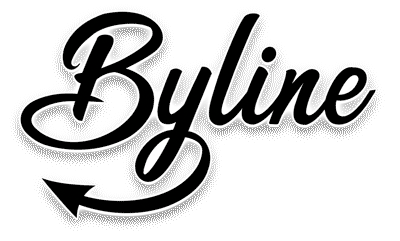About Byline
 Byline takes 9th–12th graders on a wild quest for stories left untold in the forgotten corners of history. As they step into the role of a 1930s-era newspaper reporter, students train under Editor-in-Chief, Daniel Schwabauer, who takes students under his wings to teach them everything he knows. Along the way, and before they even realize what they are doing, students learn to write great essays!
Byline takes 9th–12th graders on a wild quest for stories left untold in the forgotten corners of history. As they step into the role of a 1930s-era newspaper reporter, students train under Editor-in-Chief, Daniel Schwabauer, who takes students under his wings to teach them everything he knows. Along the way, and before they even realize what they are doing, students learn to write great essays!
Byline combines writing instruction with intriguing historic people and events to not only equip students with essay-writing skills, but to help them enjoy the journey!
Award-winning author Daniel Schwabauer, creator of the highly-praised One Year Adventure Novel and Cover Story, fuses journalism with history in this innovative “chronojournalism” course.
Your student will study the work of great journalists of the past, including:
• Rudyard Kipling
• Mark Twain
• Nellie Bly
• Ernest Hemingway
• Jacob Riis
• James Connolly
• H. L. Mencken
• Jack London
• Joseph Pulitzer
• Damon Runyon
• Lincoln Steffens
• Ida Tarbell
• Ray Stannard Baker
• Grantland Rice
• Russell B. Porter
• Mary Ann Shadd
• William Allen White
• Richard Harding Davis
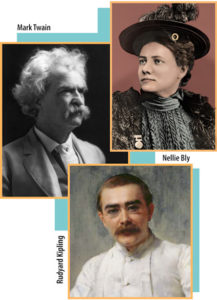
Students discover the power of words to shape history!
|
Course Philosophy
|
Journalism trains the mind to write great essays. For years, families have been asking Daniel Schwabauer to create a curriculum to teach essay writing. Byline is his answer.
On the surface, a journalism course may not seem to teach essay writing, but the truth is, the skill set required for journalism translates to writing strong essays. It translates so well that it can result in better essays than those produced by students consciously concentrating on the formal essay structure. That the connection isn’t obvious is a terrific asset, because many teens balk at the thought of essays, but get them thinking about reporting on fascinating historical events, and they are intrigued.
Read Daniel’s thoughts on this in his own words »
At Clear Water Press, we are known for our revolutionary approach to writing instruction. We turn the refrain “What’s the point of writing?” around, training it back on students. “What do you think the point of writing should be?” we ask. Or, to put it another way, “What do you want to write about?”
In our flagship curriculum, The One Year Adventure Novel, we help young writers uncover the secrets of storytelling in the stories they read, watch, and write. In Cover Story, our middle school curriculum, we harness students’ hobbies and interests to walk them through creating their very own themed magazine. There is more of storytelling in good essays than most people know, and certainly many of the skills that go into writing articles for a magazine lay the foundation for academic writing, but in Byline—in journalism—we offer students a direct way to master the scariest of all assignments: the essay. And we do it in a fun and altogether fascinating format: We enlist the student as a “cub reporter” in Daniel Schwabauer’s own fictional newspaper, The Metropolitan World.
If your student’s essay writing skills need boning up, why not encourage your student to apply for the open position writing for The Metropolitan World? Together, Daniel Schwabauer and your student will uncover the untold stories of the past.
Skills your student will learn:
CRITICAL THINKING:
If you can’t think well, you won’t write well. Writing is about putting thoughts onto paper. Observation, inference, analysis, and interpretation are essential to writing.
SEPARATING FACT FROM INTERPRETATION:
Byline inoculates students against propaganda. Propaganda isn’t about telling lies. It’s about creating interpretations of facts. The student who learns to separate fact from interpretation is much harder to indoctrinate.
WRITING INTELLIGENTLY WITHOUT JARGON:
Byline challenges the common misconception that obtuse writing impresses college professors. Clear writing is the key. No young writer should have to resort to jargon and fancy-sounding sentences. Byline frees students to write directly and from the heart.
FOLLOWING LEADS:
Whether working to uncover a specific story on the orders of the Editor or following a lead of their own, students will discover how an intriguing detail can be a clue to an untold story, submerged in time. Byline offers your student reporter “100 Tips” about notable, heroic, or bizarre individuals, each designed to be the beginning of a chronojournalism adventure. Learning to conduct research has never been more fun!
SUPPORTING EVIDENCE:
Good journalists back up their exposés. So will your student reporter. Byline is a great introduction to the ethics of quality citations. And you know what academic essays require? Citations. With Byline under their belt, students will see citations for what they are: the evidence of first-class reporting.
Byline is 1 High School English credit, with the option of earning a half History credit as well.
|
The Curriculum includes:
|
• 72 video lessons accessed via a 12-month Cloud video streaming (renewable)
• The Training Manual, a reporter’s instructional book
• The Reporter’s Notebook
• Teacher’s Guide with simple weekly summaries of what to expect from your student
• The Metropolitan World, a printed newspaper of example articles
• The Retro Metro, a printed newspaper of historic pieces of journalism
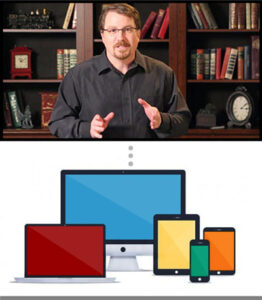
Video Lessons
All the instruction in Byline is done for you by Daniel Schwabauer, in the guise of the 1930s editor of the fictional Metropolitan World. Byline opens with a How to Use video and a Parents & Teachers video followed by 72 video lessons, each 15–20 minutes long. Students begin with watching a video lesson and then proceed, as instructed, to complete assignments in the Training Manual and Reporter’s Notebook.
Video and audio are high quality and are accessible via a Cloud video streaming subscription. Watch anywhere with a strong Internet connection, world over.
“Benefits of Cloud Streaming” »
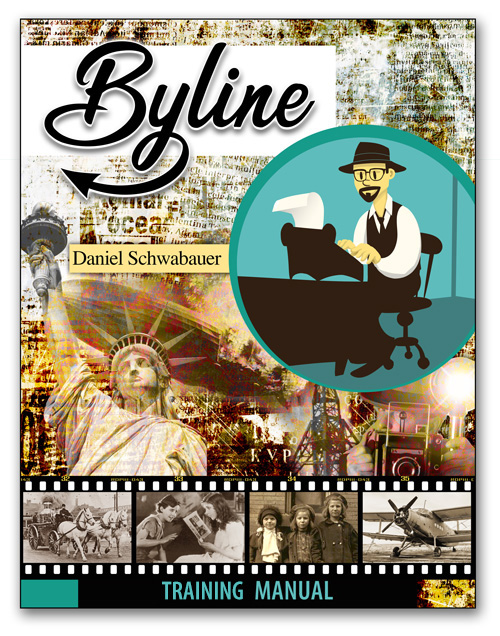
Training Manual
More than just another textbook, the Training Manual is written as a series of inter-office memos, notes, training exercises, and selected readings—all chosen by the editor of the Metropolitan World for the benefit of his newest cub reporter. The relaxed tone and inside-scoop flavor of the manual invites students on a journey of discovery.
The Editor is there every step of the way, so students can confidently write “Yesterday’s News Today!”
Each lesson reinforces and expands on the material in the videos, and a special TIPS section in the back provides over 100 breadcrumbs for interesting story possibilities.
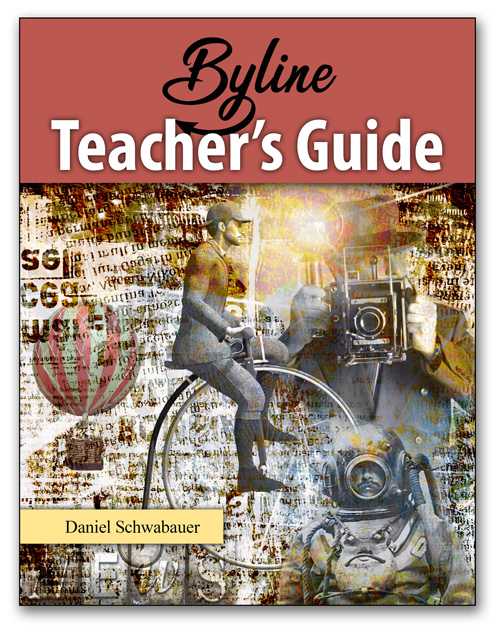
Teacher’s Guide
The Teacher’s Guide contains answer keys and unit tests, but it does more: It provides you, the educator, with week-by-week summaries of what your student is learning. We know you need to support your student even if Daniel Schwabauer is doing the teaching. Byline performs the delicate balancing act of both taking weight off your shoulders and supplying you with the information you need to follow your student’s journey. Each weekly summary is one page long and tells you what creative project your student reporter is undertaking, what that week’s key concepts are, and what to focus on when assessing your student’s work.
“How to Use and Grade Byline” »
+ The Reporter’s Notebook
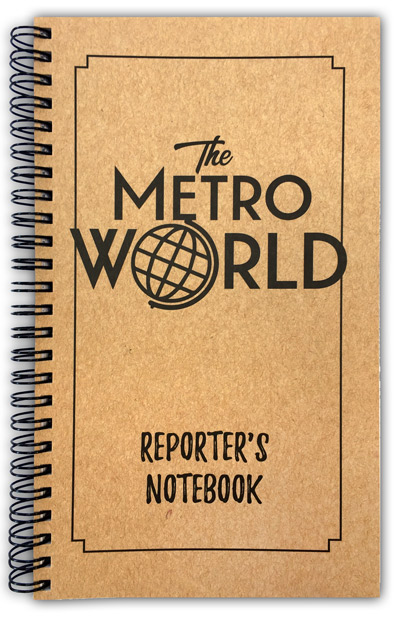 The Reporter’s Notebook is laid out to correspond to the lessons on video and in the Training Manual. It helps student journalists separate fact from opinion and encourages observation on two levels. Good writers notice interesting details in stories and in life. But they don’t just notice the details. They also notice their own reactions to those details. The Reporter’s Notebook is designed to help student reporters interpret their findings and observations by organizing them into Questions and Answers. It is also formatted to develop good citation skills—necessary for academic essays at the college level.
The Reporter’s Notebook is laid out to correspond to the lessons on video and in the Training Manual. It helps student journalists separate fact from opinion and encourages observation on two levels. Good writers notice interesting details in stories and in life. But they don’t just notice the details. They also notice their own reactions to those details. The Reporter’s Notebook is designed to help student reporters interpret their findings and observations by organizing them into Questions and Answers. It is also formatted to develop good citation skills—necessary for academic essays at the college level.
The patterns used in The Reporter’s Notebook reinforce the story structures and outlines used throughout the course, building writing habits that will carry over to other types of writing.
+ The Metropolitan World
Byline comes with a high-quality print copy of the Metropolitan World. Written by Mr. S., this newspaper contains examples of every type of story required for the course. Although reading the Metro isn’t strictly required, students may find its stories helpful as models of the various techniques and structures taught in the course.
+ The Retro Metro
Like the Metropolitan World, the Retro is a high-quality print newspaper containing models of the various assignments. Unlike the Metro, these stories are taken from the work of historic journalists such as Mark Twain, Ernest Hemingway, Nellie Bly, Ray Stannard Baker, Grantland Rice, William Allen White, and Richard Harding Davis.
Extra Student Kits include the consumable Training Manual, the Reporter’s Notebook, and the print newspapers.
|
Pieces Your Student Will Write:
|
Byline reporters write all kinds of pieces for the Metro World, ranging from short press releases and news briefs of 100–300 words to long Op Eds, personality features, sports stories, and narratives of 500–800 words—or more!
Writing assignments are pegged at two different levels, in view of Byline‘s wide grade range, 9th–12th grade. Read about the Flex Projects below!
 The 22 varied newspaper pieces student reporters undertake cover the following types of essays:
The 22 varied newspaper pieces student reporters undertake cover the following types of essays:
• Expository
• Descriptive
• Persuasive
• Narrative
By the end of Byline, your student reporter will have logged over 9,000 words—probably much more! If you pasted all 9,000 words into one double-spaced document, that’s over 37 pages in Times New Roman font!
|
What Are “Flex Projects”?
|
Byline may be used for any one school year in grades 9 through 12. As with The One Year Adventure Novel, older students will get more out of the course than younger ones, primarily because they bring more life experience and a more mature understanding of people and history.
To make the course accessible for younger or struggling students, six of the 22 writing assignments are marked as Flex Projects. This means students do not need to write the actual paper to receive full credit, as long as they complete the readings, exercises, and outlining included in the Training Manual and Reporter’s Notebook.
Byline is divided into six units, with one Flex Project per unit. Students on the Flex Track complete 16 projects/essays by the end of the school year. Older students write all 22. A reporter on the Flex Track will log at least 5,000 words, as contrasted with the 9,000+ logged by older reporters.
|
Syllabus
|
- Adapt the course to a group setting or a different pace (we are happy to help by email and phone as well!)
- Plan logical breaking points around holidays or special events.
- Submit information to your student’s advisor/teacher at a charter school.
- Submit evidence that the course is worth 1 high school English credit.
Read about how to use & grade Byline »
|
Lessons
|
Overview of Writing Topics & Concepts:
• Note-taking strategies
• How to research and keep track of sources
• Outlining & creating beats in a story sequence
• How to identify angles in a story
• The art of a compelling headline and summary
• Revising and copy editing
|
|

